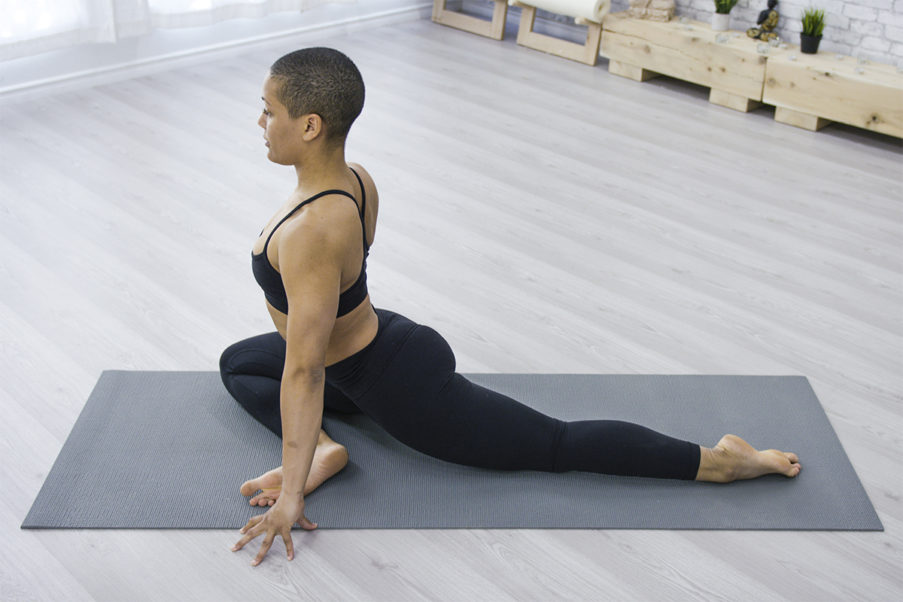How to Become a Yoga Instructor
Do you have the skill, temperament and business sense to become a yoga instructor?
If you are enthusiastic about yoga and have seen its transformative effect in your own life, it’s natural to want to share that with others. And if you are comfortable in front of a group but also know how to connect one-on-one, teaching yoga may be a perfect fit. A yoga instructor is expected to lead a positive group experience (like a group fitness instructor), while providing ongoing personalized feedback (like a personal trainer). If you have the creativity and business sense to market yourself well, even better. Yoga teachers quickly find that they are responsible for building the size of their classes and must take networking and marketing seriously if they want to develop a client base for private sessions.
But even more than classroom charisma or marketing skills, what a yoga instructor needs is a dedicated personal yoga practice. As a yoga teacher, you will do more than lead people through postures. You will be a role model for the benefits of a yoga practice. This is why most yoga teacher-training programs require at least two years of committed yoga practice. Yoga instructors must model a mindful presence, a welcoming attitude and a compassionate approach to working with physical limits and challenges. Your own practice will give you a deep understanding of postures; help you establish a healthy relationship with your body; and teach you how to relate skillfully to challenges (including difficult students and classroom inconveniences!).
What Certification or Training Do I Need?
Basic Training. There are no universal agencies set up to provide examinations and certifications for yoga teachers as there are for group fitness instructors and personal trainers. Instead, the standard baseline training for a yoga instructor is a 200-hour “contact” program, meaning you spend 200 hours in a hands-on learning environment. Programs like this may offer their own certification. Some 200-hour programs consist of an intensive monthlong retreat experience; others space the training over two years in a series of weekend workshops or several long retreats. Specific styles or schools of yoga may have additional requirements, including mentoring with experienced teachers and having one’s personal yoga practice and classes observed and evaluated.
Although it is possible to obtain a specialty fitness yoga certificate or online certification in less than 200 hours or through home learning, it will not be recognized by Yoga Alliance, the national registry of yoga instructors. Yoga studios are unlikely to hire an instructor who has not completed a 200-hour training. And while many certified fitness instructors with limited yoga training find themselves teaching yoga in fitness facilities and community centers, even traditional fitness managers expect new yoga instructors to have a 200-hour certification.
All 200-hour training programs are required to offer instruction in more than just the exercise and relaxation components of yoga. You will also be introduced to yoga philosophy; anatomy and physiology; and teaching methods, including hands-on touch. The specific focus of these components varies widely from program to program. For example, in some programs’ anatomy and physiology sections, you will spend most of your time learning muscles and bones, and how postures affect them. In other programs, those anatomy and physiology hours may include a heavy emphasis on traditional yoga concepts, such as chakras, nadis, prana and Ayurvedic principles. Do your homework to make sure the orientation of a program is a good match for your own. Find out where teachers you respect did their training, or ask a local gym or studio for suggestions. If you can, take classes with the trainers, so you know whether you connect well with their approach. Talk to graduates of the program and ask what their experience was like.
Yoga Alliance has a complete list of registered 200-hour training programs in the United States. Tuition varies, but expect to spend $2,000 or more, especially if you will need to pay for lodging. Yoga teacher-training programs are not (at current writing) eligible for educational loans, and scholarships, while available for some programs, are rare.
More Advanced Training. If you are ready to go beyond basic training, 500-hour programs will further your teaching skills and develop your abilities to work with special populations (e.g., people with health challenges). These programs typically take one to two years to complete, and many are equivalent in time commitment and intensity to a master’s degree. Like 200-hour trainings, they typically cost several thousand dollars and up. Some styles of yoga also have multiple levels of certifications; for example, junior instructor, senior instructor and master teacher (who can train new teachers). These hierarchies vary by system, but reaching the highest level typically requires many years of continued teaching and training within the system.
How Do I Find a Job as an Instructor?
Many fitness facilities and community centers will hire newly certified yoga instructors, but just e-mailing your resumé is usually not enough to get yourself on the group fitness schedule. Visit local centers and chat with the front-desk staff about the group fitness program. Buy a guest pass and take a class to better understand the population at each center. You may be asked to teach a demonstration class, and it’s important to think beforehand about what level and style of class will suit the center’s participants.
Once you have a feel for a facility, find out who the group fitness director is, and ask to meet briefly with him or her. Inquire about adding your name to the sublist. If the director agrees, ask for permission to observe or take a few classes so you can offer a great experience when your time comes to teach.
New instructors can also propose a series of yoga classes to organizations and communities where they are already involved. For example, you could start a lunchtime class in your workplace, offer an afterschool class to teachers at your kids’ school or launch a yoga group at your church. Dance studios and martial arts centers may also be interested in adding a yoga class to their schedules, for either kids or parents. In these venues, extensive teaching experience will matter less than the fact that you are part of the community.
On the other hand, most yoga studios (including those in spas or retreat centers) want experienced teachers with an established following. Studios are reluctant to hire brand-new instructors. If you want to teach at a particular studio, make yourself a known presence there. Become a regular student in the classes you hope to sub. Get to know the front-desk staff and studio managers. Offer to assist the teachers whose styles are closest to yours. By establishing yourself as an active member of the yoga studio’s community, you will greatly increase your chance of getting a subbing gig and class of your own.
Corporate yoga—offered in the workplace—is a growing trend. Classes are often arranged by a company that sends instructors to various work sites. To find such a company in your area, conduct a Web search for corporate yoga, fitness or wellness.
Can I Make a Living Teaching Yoga?
It is possible to make a living as a yoga instructor, but most successful instructors need to supplement their income from group classes with more lucrative workshops, retreats and private instruction.
Rates and methods of pay for yoga instructors range widely. The 2008 IDEA Fitness Industry Compensation Survey, published by IDEA Health & Fitness Association, found that 63% of instructors were paid by the class, 32% by the hour and 22% by the number of participants; just 2% were paid a salary. (Survey respondents were IDEA members.) The average rate of pay per hour or class was $32.25, with for-profit companies generally paying close to $35 and nonprofit organizations offering about $10 less (Schroeder 2009).
If you teach in a yoga studio or rent a space to teach, you will likely be paid by the number of students you have. For example, a studio may offer a $20 base pay per 90-minute class, plus $2–$5 per student. So with 20 students, you’d earn $60–$120. If you rent a space, you will keep whatever you charge minus the rental fee. Both of these arrangements have big-money potential if you can pack a room, but your pay will be dismal if only a few students turn up.
Studios and facilities will expect you to market your classes to build the numbers. You can promote yourself effectively through traditional means (e.g., fliers, community networking, a website) or new social media (e.g., blogging, podcasting, posting yoga videos on Youtube)—but know that you won’t be able to spend all your time designing brilliant lesson plans and music playlists.
If you teach in a fitness facility or community center, you will probably be paid by the class. Usual pay rates range from $15 per class at the low end (typically for new instructors in community centers) to $80 per class or more for experienced instructors in high-end facilities or university fitness programs. Corporate classes often offer a pay rate closer to the high end of the spectrum, especially if you work directly with the business to set up the class and can choose what to charge. If you work as a contractor for a fitness company that sends instructors to workplaces, you will likely earn less.
Yoga instructors who have completed a 200-hour training program can offer private lessons without obtaining additional qualifications or a personal trainer certification. Private lessons can be a good source of income, with most teachers charging $50–$150 per 60- to 90-minute session. Sought-after or experienced instructors may charge much more than this. However, it is difficult to build a client base without also teaching group classes or building referral relationships with allied health professionals (e.g., chiropractors, massage therapists and psychologists).
How Can I Expand My Career?
Once you have completed your training and acquired some teaching experience, there are many things you can do to build your business.
Assisting/Mentoring With Established Teachers. One of the best ways to receive free, ongoing training is to assist an established teacher. Assistants help out in classes and workshops or handle administrative details. Although assistants are typically not paid, what you learn from observing and working with a senior teacher is worth the time. You will also gain credibility in the yoga community as someone who can teach in a specific style and has the stamp of approval of a respected teacher. Before asking to assist or mentor with a teacher, become a familiar face. Take classes from the teacher and observe how she relates to her students. Think about ways to help, such as serving as the check-in and payment person for an instructor who runs his own class/workshop space; offering hands-on touch in large classes; or making sure all participants have the props they need and know what to do with them.
Specialty Certifications and Training. Once you have finished a basic 200-hour program, you can pursue further trainings in specialties such as prenatal yoga, kids’ yoga, yoga for back pain, mindfulness-based stress reduction and yoga for seniors. These trainings allow you to offer specialized classes and workshops or teach in settings not typically open to yoga instructors (such as elementary schools or hospitals). Specialty certification programs range from a single weekend workshop to several months of ongoing training.
Yoga therapy—for people with significant mental or physical health challenges—is a subspecialty that requires considerably more advanced training. A 500-hour program over one to two years would be appropriate. More information about yoga therapy training is available from the International Association of Yoga Therapists.
Beyond the Classroom. More so than in other areas of the fitness industry, workshops and trips are big business for yoga instructors. Practitioners want opportunities to explore yoga in depth or to combine it with other things they love. Yoga and surfing, yoga and chocolate, yoga and dogs—you name it and it’s been done successfully by teachers who know how to create unique experiences!
For instructors with a head for business and good organizational skills, managing or even owning a yoga studio can provide a steady base income. However, many teachers discover that once they are behind the desk and responsible for daily operations, it is difficult to find the time and energy to teach, or even take, classes. Have a clear sense of where your passion and strengths lie, and choose a path that will keep you connected to your daily work in the ways that matter most to you.
Special Concerns for Yoga Instructors
Employee vs. Self-Employed. As a yoga instructor, you may have special tax considerations, depending on your hiring status. Instructors are split more or less evenly between employees and independent contractors (Schroeder 2009). Many fitness facilities and community centers will pay you as an employee, taking federal and state taxes out of your paycheck and contributing half of your Social Security taxes. However, most yoga studios hire their instructors as independent contractors. Being an independent contractor means you are legally considered self-employed. If you run your own classes by renting space and charging participants, you are also considered self-employed.
When you are self-employed, no taxes are withheld from your pay. This means you are responsible for filing quarterly tax payments to the federal and state governments. You are also required to pay an additional self-employment tax (currently 15.3%) on top of your federal income tax. For more information about how to file quarterly self-employment taxes, read the online guide provided by the Internal Revenue Service.
The good news is that self-employed instructors can deduct business expenses from their tax liability. For yoga teachers, these expenses typically include props, music, advertising, space rental, continued training, yoga conference travel, teaching insurance and individual healthcare insurance. (Unfortunately, yoga clothes are not tax-deductible unless you never wear them outside of the classroom.) Keep careful records of your business spending, and save your receipts.
Teacher’s Insurance and Liability Waivers. Yoga instructors are often responsible for obtaining their own individual liability insurance. For “less than 50 cents per day,” IDEA—in partnership with Fitness and Wellness Insurance—offers coverage of up to $2 million per occurrence, with an aggregate limit of twice that per year. Another popular policy is available through Yoga Journal
Insurance companies may require all your new students to sign a liability waiver. If you teach in a studio or fitness center, the facility will probably provide a waiver. But if you teach elsewhere, it is a good idea to have your own. A very simple waiver form is available from Yoga Alliance.
Codes of Ethics. Modern yoga has its roots in traditional philosophies with strong codes of ethics that espouse nonviolence, honesty and no engagement in exploitative sexual relationships. For this reason, many professional yoga teacher associations require their members to endorse specific codes of conduct, and yoga studios may ask you to sign a contract committing to ethical conduct. An example of a yoga teacher’s code of ethics is available from the California Yoga Teachers Association.
Ethics codes for yoga instructors go beyond what is commonly expected of fitness professionals. Of particular note is a pledge not to engage in “dual relationships” with students, which includes personal friendships and sexual relationships. This is a common standard in healthcare professions, such as medicine and psychology, and acknowledges that yoga instructors are trusted with caring for a student’s body and mind.
Ready for a Career in Yoga?
So, do you have what it takes to make a career out of yoga? If you have developed a strong personal practice and are willing to commit to at least 200 hours of training; if you enjoy teaching and will honor yoga’s code of ethics; and if you can navigate your way through the business of yoga—then why not follow your passion and become a yoga instructor! Get started by finding a yoga certification that fits your needs by searching here
References
Schroeder, J. 2009. 2008 IDEA Fitness Industry Compensation Survey. IDEA Fitness Journal, 6 (1), 31-42





